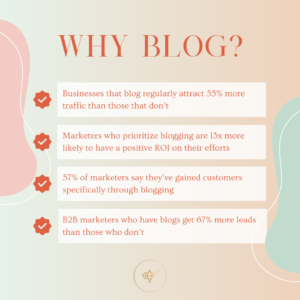You’ve come up with the topics, written the blog posts, double checked the spelling—but your blog posts just aren’t getting the traffic you want or need. After all of that work, your efforts may feel futile but don’t give up! Blogging is an incredibly important part of every content strategy and we’re here to share a few ways how to increase your blog traffic.
Blogging has evolved drastically over the years—starting out simply as people sharing personal thoughts online (sort of like a journal) and then slowly evolving and becoming part of a content marketing industry that’s worth over $400 billion. With the rise of various social media platforms, we often see blogging being pushed to the side or completely ignored by companies, which is a huge missed opportunity—but why is blogging so important? Check out the graphic below for a few stats, they really don’t need any further explanation.
 Thanks to platforms like WordPress or blogging integrations with sites like Shopify, starting or adding a blog to your website has become quite easy—but how do you drive traffic once your blog is set up? Keep reading to find out!
Thanks to platforms like WordPress or blogging integrations with sites like Shopify, starting or adding a blog to your website has become quite easy—but how do you drive traffic once your blog is set up? Keep reading to find out!
Optimize your blog posts for SEO
With all of the talk about paid online advertising, you might be surprised to learn that organic searches on Google drive a huge chunk of traffic for most websites. To maximize your SEO ranking, it’s important to optimize your blog posts for important SEO ranking factors such as page speed, mobile friendliness, content length, use of keywords, and linking, among others. Read more from woman-owned SEO & Digital Marketing company and our friends at the Know Agency in their blog post on how to optimize your content for SEO.
Keyword research
Why guess what your intended audience might be interested in when you can do keyword research to find out? Keyword research is a technique used to help you discover specific words, topics, or sentences that users are interested in based on search engine data.
After you’ve discovered the keywords most important to your intended audience, you can use them to plan your content strategy. When you know what your target audience is looking for, you can optimize your content to deliver the answers they need. Plus it’s a great way to find new content ideas, learn what your competitors are (or aren’t) doing, and help drive traffic to your blog.
Now that you know what keyword research is and why it’s important, the question is how do you actually do it? Luckily, there are a lot of free (and paid) keyword research tools that can help. Check out wpbeginner’s 8 Best Keyword Research Tools for SEO in 2021 for a few suggestions.
Create a Content Schedule
Once you’ve gotten the keyword research out of the way, it’s likely that you’ll come up with a long list of content ideas for blog posts. Instead of trying to churn these out all at once, create a game plan—take all the ideas that you’ve come up with and lay out a realistic schedule so that you don’t get overwhelmed. Posting blogs on a regular basis is an important element in driving traffic to your blog and creating a content schedule will help you stick to the plan.
Make Your Content Readable
Readability is an important factor when it comes to search engine optimization. Since computer and mobile screens are still not optimal for reading, users typically tend to scan to see what, if anything, piques their interest. This is why making sure your blog posts are readable is key in driving traffic to your blog.
Improve readability on your blog posts by using:
- shorter sentences
- smaller paragraphs
- punctuation
- headings
- bulleted lists
- white space around text
- images, video, etc. (articles with images get 94% more views than those with no visuals!)
Still not sure if your blog posts are readable? Check out all of the all-in-one SEO plugins that are out there to help improve your readability and boost your SEO to drive more traffic to your blog.
Internal Linking
Linking to your own content from your other blog posts and pages? It’s a yes from us! Search engines assign each page on your website a score and although the algorithm of this score is not public knowledge, we know that Google follows links to discover content on websites and to rank this content in the search results. By using internal linking, you’re helping Google to understand the relevance of posts, the relationship between them, and the value of those posts.
Using internal linking will not only help drive traffic to your blog, but will also help boost your page views, increase the amount of time users spend on your site, and ultimately will improve the SEO score of your individual blog posts.
Share to social media
While Google claims that sharing your blog posts to social media doesn’t help with SEO, we know for a fact that it does drive traffic to your blog which actually is an important factor in boosting your SEO. Any time you add a new blog post to your site—share, share, share! The more eyes on your blog posts, the better!
You can also use this as an opportunity to re-share old blog posts to social media to help drive traffic to your blog. Before doing so, we recommend updating old posts with relevant internal links, changing the current year in headings, and making sure the posts you’re re-sharing are still relevant.
Have questions on how to increase your blog traffic? Contact the genies today!


